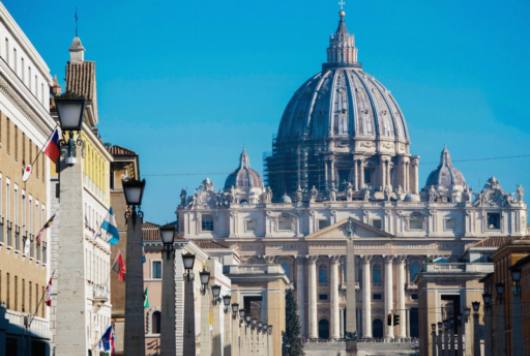The Dome of St. Peter's Basilica is a masterpiece of engineering and artistry that has stood as a symbol of the Vatican City for centuries. Its construction posed numerous challenges, yet its design holds deep symbolic meaning and artistic beauty. The dome's historical significance is profound, serving as a testament to the enduring legacy of the Catholic Church and the city-state of Vatican City.

Construction Challenges Faced
Peter's Basilica posed several challenges for the architects and builders involved. One of the main challenges was the sheer size and weight of the dome. It is one of the largest domes in the world, measuring 136 meters in height and 42 meters in diameter. This required innovative engineering techniques to ensure its stability and longevity.
Additionally, the dome was built on top of an existing basilica, the original St. Peter's Basilica, which posed structural challenges. The architects had to ensure that the new dome would not put too much pressure on the existing structure below. They achieved this by using lightweight materials and distributing the weight of the dome evenly across the base.
Another challenge was the construction of the dome's lantern, which sits on top of the dome and houses a large cross. This required intricate masonry work and precise calculations to ensure that it would not collapse under its own weight.
Despite these challenges, the architects and builders persevered and successfully completed the construction of the Dome of St. Peter's Basilica, creating a masterpiece of architecture that stands as a symbol of the Catholic Church and a testament to human ingenuity.
Symbolism Behind the Dome's Design
The design of the dome of St. Peter's Basilica is filled with rich symbolism intended to emphasize the spiritual significance of the structure. The dome, rising high above the city of Rome, is often seen as a representation of the heavens and God's kingdom. The circular shape of the dome is meant to symbolize unity and eternity, reflecting the eternal nature of God. The rising height of the dome represents the journey of the soul towards salvation and enlightenment. The lantern at the top of the dome is a symbol of divine light and guidance, leading believers towards the truth. Overall, the design of the dome is meant to inspire awe and reverence in those who gaze upon it, reminding them of the power and majesty of the divine.
Artistic Elements of the Dome
The Dome of St. Peter's Basilica is a prime example of artistic brilliance and engineering excellence. The dome is a masterpiece of Renaissance architecture and is adorned with intricate designs and decorations. One of the most notable artistic elements of the dome is the stunning coffered ceiling, which features intricate patterns and geometric shapes. The use of light and shadow in the design of the dome creates a dramatic effect, highlighting the beauty and grandeur of the structure. The frescoes on the interior of the dome, painted by renowned artists such as Michelangelo and Rafael, add to the artistic value of the dome and tell stories from the Bible. The statues that adorn the exterior of the dome are also impressive works of art, depicting various saints and angels in exquisite detail. The artistic elements of the Dome of St. Peter's Basilica reflect the skill and creativity of the artists and architects involved in its construction, making it a true marvel of human achievement.
Historical Significance of the Dome
The historical significance of the Dome of St. Peter's Basilica is immense. Built in the 16th century, the dome stands as a testament to the ingenuity and craftsmanship of the Renaissance period. It is a symbol of the power and influence of the Catholic Church during this time, as well as a representation of the grandeur and splendor of Rome as the center of the Christian world. The dome also serves as a reminder of the long and complex history of Rome and the Vatican, and continues to attract visitors from around the world who marvel at its beauty and historical importance.
